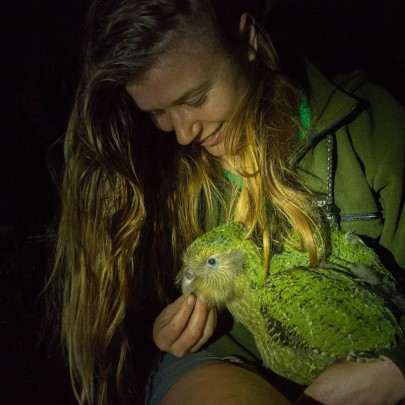
Dr Jo Carpenter with a kākāpō on Anchor Island, one of the pest-free islands where the birds now live.
A new study led by Manaaki Whenua - Landcare Research researcher Dr Jo Carpenter, designed to better understand the dynamic processes of extinction, has shed new light on what led up to the near-terminal decline of kākāpō. Dr Carpenter and her co-authors Dr Janet Wilmshurst (Manaaki Whenua - Landcare Research) and Prof George Perry (University of Auckland) used a unique combination of fossil and recent (post-1769) historical records to examine how kākāpō distributions changed through time.
“Historical newspaper articles from the nineteenth and twentieth centuries are a treasure trove of information on where kākāpō were distributed,” says Dr Carpenter. “We also gathered information from kākāpō museum specimens, by recording when and where they were collected.”
These data were used to predict the kākāpō’s likely local extinction dates, which were between 1936 and 1959 in the North Island, and between 1990 and 2006 in the South Island – a time lag of around 31-70 years. The researchers explain this time lag as resulting from different prehistoric hunting and predation pressures, and extents of habitat transformation on the North and South Islands.
In the historic era, packs of feral dogs appeared to be a less important driver of kākāpō decline. “Our analysis of more than 100 geo-referenced newspaper and scientific reports shows the distribution of kākāpō and feral dog packs did not overlap strongly anywhere, suggesting they did not frequently interact,” says Jo. “Kākāpō also persisted in the South Island for up to 70 years after the last noted observation there of feral dogs in 1913.”
Conversely, the explorers were right about the European-introduced stoats, possums, cats, Norway and ship rats, which have been a much more important contributor to kākāpō decline since European arrival. “These animals would certainly have been the coup de grâce for this species if the birds hadn’t been rescued from the wild,” says Dr Wilmshurst.
In 1995, the kākāpō population had fallen as low as 51 known individuals.
In 2023, thanks to years of intensive conservation efforts by the Department of Conservation Kākāpō Recovery Group and Ngāi Tahu (kaitiaki of kākāpō), numbers of this critically endangered species have rebounded, with approximately 250 birds now confined to offshore, predator-free islands.

